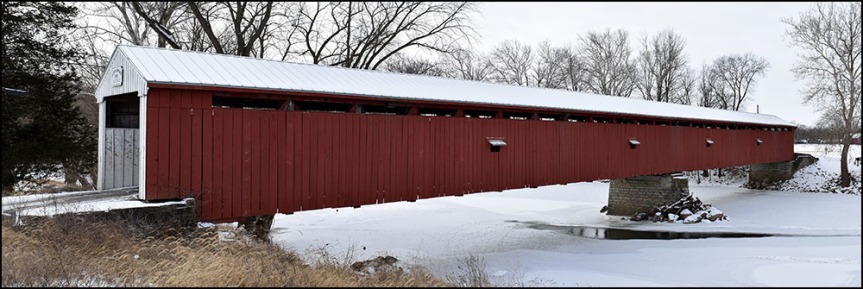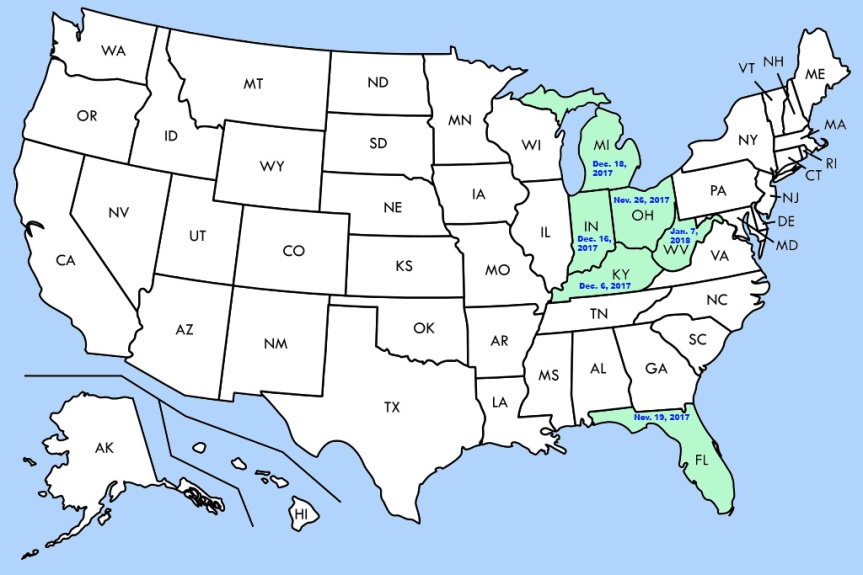
(Jan. 8, 2018) I’m sitting in Charles Town, West Virginia, tonight. Tomorrow (weather permitting) I’ll tour Harpers Ferry. I did my master’s thesis on John Brown and how he became such an avatar of terror for the Antebellum South that his 1859 raid is (rightly, I think) regarded as one of the specific events that helped spark the Civil War. I haven’t been to the site of his raid into then-Virginia (this was before these counties broke away to form West Virginia during the way) since I was a very little boy.
I said “weather permitting” because a winter weather advisory has been issued. I might spend tomorrow in the hotel while freezing rain freezes the cojones out of the area.
Starting with the Serpent Mound in Ohio, a unique set of events has lead me to ping-pong between two very different types of sites, both of which create poignant bridges to the past. It’s also been a good lesson in being flexible in my planning.
After the Serpent Mound, I headed back north to Greenville, Ohio, to visit the Garst Museum. The Garst Museum houses the national Annie Oakley Center, and I was looking forward to learning about her. However, I learned I really need to read the fine print on a website…and the museum should not put a note about being closed for the month of January in fine print! My whole reason for going to Greenville was shot.
At my hotel, I decided to Google “Indian Mounds near me” to see if there were any mound sites in close proximity. I didn’t find anything within a day’s drive, so I Googled “historic sites near me.” The first thing that caught my eye was a listing of historic covered bridges in Ohio. Turns out Ohio has the second most existing covered bridges of any state in the Union. As I read on, I learned the bridges were not covered to protect the traffic on them, but to protect the wooden structures themselves. With the covering, the wooden structure could last for centuries with regular maintenance.
Wooden covered bridges were used in Europe long before the concept came to our shores. However, for some reason, these structures have become iconic of the American heartland.
My first was Eldean Covered Bridge across the Great Miami River over in Troy, Ohio. I visited it Jan. 4. Eldean was built in 1860 and can still carry traffic despite its age. Eldean Road has since bypassed the old bridge in favor of a modern span that can handle things like 18-wheelers, and the covered bridge is now part of a park…but you can still drive your 21st century car across this 19th century wooden bridge (as long as the car is under 2 tons).
It was an icy day as the record-smashing arctic temperatures we’ve been experiencing kept the Midwest in their grip. The Great Miami River was frozen over, the skin of my face stung, and even breathing was painful in the chill. But this long, red, covered bridge standing strong against the January wind was something to see, touch, and drive across. Thinking about all those who crossed it as I drove Sara Jane, my 2007 Kia Sorento, over it, was a meaningful experience. Hearing the wood creak under her wheels created a real sense of unity with history.

These are my favorite kind of antiques and sites—the kind that still operate despite their age. Touching them, using them, and interacting with them as they were designed to be used gives us a direct connection to our predecessors in the past. This isn’t some artifact under glass we can only look at—this is a living artifact we can still drive over…just as our ancestors did. We touch their world and their time when we do.
The next day (Jan. 5) I drove south of Greenville to go bridge hunting. I found five bridges, all much smaller than Eldean. Four were built by Everett S. Sherman, a prodigious bridge builder who constructed more covered bridges than anyone else in Ohio. Three of these are still in service carrying regular traffic. The fifth bridge of the day was Roberts Bridge, the oldest covered bridge left in Ohio (built in 1829), and the only “double-barreled” (dual-wagonway) bridge left in the state.
There is a point here. Stay with me.
As I started to leave Ohio on Jan. 6, I decided to Google covered bridges again while I was in the south eastern part of the state. I nailed Byers Bridge, an 1872 structure still carrying traffic over Pigeon Creek. Byers is way out in the countryside of this mountainous region. It took me 20 minutes to find it, even though it was only 6 miles (as the crow flies) from my route towards West Virginia.
While finding this bridge, I happened across the Leo Petroglyphs. This is a collection of 40 images carved into a boulder, most likely by the Fort Ancient culture about 700 years ago. There are birds, a snake, several human footprints, a stick figure, and a remarkably odd smiling face wearing a headdress. Today the boulder is protected under a shelter as part of a state park, but when you look at the figures, you’re still outdoors in the wind and (as it’s winter) cold…just like the ancient Fort Ancient people would have been.

I also got to see (and touch) frozen waterfalls for the first time in my life as I hiked around the gorge that’s part of the Leo Petroglyph park (I mentioned that for the “wow!” factor).
It happened again today here in West Virginia. While touring Harrison County, I Googled covered bridges. There were two, and I found them both. But as I searched for them, I also found the Oak Mounds in Clarksburg. There are two mounds, with the largest being located on the front lawn of the present-day Oak Mounds Evangelical Church. These are burial mounds at least 1,000 years old. They were sacred sites to the Hopewell peoples during the early Woodland period.
Now, most burial mounds are not “spectacular” sites to look at. They’re just mounds of earth, after all…at least, that’s what most 21st century people would see. But stop and look at them with different eyes. These mounds were usually burial sites…in other words, these are the graveyards of a lost people. Even the mounds that weren’t burial mounds were sacred or ceremonial sites to a culture that used what it has to build, and what they had plenty of was earth. Look at these sites with a bit of understanding, and you realize they bear silent witness to the rise and fall of civilizations on this land.
There are several salient points tonight. For starters, don’t give up. If you’re traveling and adventuring, don’t get discouraged if your intended target is unavailable. That happens. Be disappointed, but move on and look around you. You never know what you’ll find.
For me…for me an impromptu search for covered bridges detoured me past 19th century structures to the silent markers of the ancient Native Americans. The bridges from the past literally bridged me to the past, enabling me to connect a little with the first settlers to people our continent.

 #bridge #coveredbridge #ohio #westvirginia #indian #nativeamerican #burialmound #mound
#bridge #coveredbridge #ohio #westvirginia #indian #nativeamerican #burialmound #mound


Great site glad I found it. We have 59 covered bridge in New Brunswick, I have covered many of them in my posts. If you like covered bridges check my post; Bridges to cross,2017, You Travel Alone? Sussex New Brunswick Don’t just past through.
LikeLike
I am traveling alone. Well, me, my teddy bear, and Albus the Crab (check our my Instagram or Flickr, #albus or #albusthecrab. Right now the goal is all 50 states within 12 months (November 2017 – November 2018). That might be shifted a bit if I get a teaching contract teaching college history at sea for the Navy. I’ll still get all 50 in 12 months…it just might not be a contiguous 12 months! Then I’ll look at Canada. I want to see Canada very much!!!!!!
LikeLike
Very good. I still have Oregon Hawaii and Puerto Rico to complete the states, and NWT, Nunavut, NFLD and Labrador yet to do in Canada. But as I get older I realize stopping in a place for two days or driving through, does not qualify as a seeing the place. I know want to spend time looking around a place rather than driving through to say I was there. Take your time enjoy collecting the states,
LikeLiked by 1 person